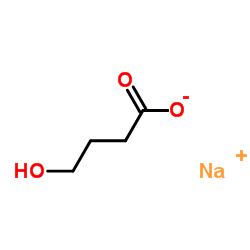4-Hydroxybutanoic acid sodium salt

4-Hydroxybutanoic acid sodium salt structure
|
Common Name | 4-Hydroxybutanoic acid sodium salt | ||
|---|---|---|---|---|
| CAS Number | 502-85-2 | Molecular Weight | 126.086 | |
| Density | N/A | Boiling Point | 295.6ºC at 760mmHg | |
| Molecular Formula | C4H8NaO3+ | Melting Point | 145-146ºC | |
| MSDS | N/A | Flash Point | 146.8ºC | |
| Symbol |



GHS02, GHS06, GHS08 |
Signal Word | Danger | |
|
An improved design of water-soluble propofol prodrugs characterized by rapid onset of action.
Anesth. Analg. 118(4) , 745-54, (2014) Phosphate ester prodrugs of propofol (fospropofol, HX0969W) were designed to avoid the unsatisfactory water solubility of the parent drug. However, in previous clinical trials, there were reported prodrug side effects such as paresthesia and pruritus. The acc... |
|
|
Treatment of alcohol dependence: recent progress and reduction of consumption.
Minerva Med. 105(6) , 447-66, (2014) Alcohol dependence (AD) is a major public health problem. Currently, three drugs for the treatment of AD have been approved by both the European Medicines Agency (EMA) and the Food and Drug Administration (FDA): acamprosate, disulfiram, and oral naltrexone. T... |
|
|
Discriminative stimulus effects of the GABAB receptor-positive modulator rac-BHFF: comparison with GABAB receptor agonists and drugs of abuse.
J. Pharmacol. Exp. Ther. 344(3) , 553-60, (2013) GABA(B) receptor-positive modulators are thought to have advantages as potential medications for anxiety, depression, and drug addiction. They may have fewer side effects than GABA(B) receptor agonists, because selective enhancement of activated receptors cou... |
|
|
Effects of monocarboxylate transporter inhibition on the oral toxicokinetics/toxicodynamics of γ-hydroxybutyrate and γ-butyrolactone.
J. Pharmacol. Exp. Ther. 345(1) , 102-10, (2013) Respiratory depression and death secondary to respiratory arrest have occurred after oral overdoses of γ-hydroxybutyrate (GHB) and its precursor γ-butyrolactone (GBL). GHB is a substrate for monocarboxylate transporters (MCTs), and increasing GHB renal cleara... |
|
|
The clinical toxicology of γ-hydroxybutyrate, γ-butyrolactone and 1,4-butanediol.
Clin. Toxicol. (Phila.) 50(6) , 458-70, (2012) Gamma-hydroxybutyrate (GHB) and its precursors, gamma-butyrolactone (GBL) and 1,4-butanediol (1,4-BD), are drugs of abuse which act primarily as central nervous system (CNS) depressants. In recent years, the rising recreational use of these drugs has led to a... |
|
|
Long-term stability of GHB in post-mortem samples and samples from living persons, stored at -20°C, using fluoride preservatives.
Forensic Sci. Int. 222(1-3) , 47-51, (2012) Reanalyses are frequently requested in forensic toxicology, and knowledge of the stability of drugs in biological samples is of major importance for the interpretation of the toxicological findings. Currently, the literature on stability of gammahydroxybutyra... |
|
|
[Liquid ecstasy in general psychiatry: a case series].
Fortschr. Neurol. Psychiatr. 81(2) , 88-94, (2013) In emergency medicine and anesthaesiology liquid ecstasy (LE), the street name for GHB, GBL or 1,4-B, has become infamous for causing severe intoxications and withdrawal. In general psychiatry, however, it is little known. Therefore, we set out to gather data... |
|
|
Preference for gamma-hydroxybutyrate (GHB) in current users.
J. Exp. Anal. Behav. 97(3) , 323-31, (2012) Gamma-hydroxybutyrate (GHB) is a drug with significant abuse potential. The present study aimed to assess the relative value of escalating doses of GHB to current GHB users via the Multiple Choice Procedure (MCP), and to validate that the dose rated highest w... |
|
|
γ-Hydroxybutyrate toxicity mimicking basilar artery stroke.
Br. J. Hosp. Med. (Lond.) 73(7) , 412-3, (2012)
|
|
|
Sodium oxybate intolerance associated with familial serum acylcarnitine elevation.
J. Clin. Sleep Med. 9(1) , 71-2, (2013) Our case describes clinical features of two families defined by joint phenotypes: sodium oxybate intolerance and elevated serum acylcarnitines. Oxybate intolerance variably presents as either cervical dystonia or sleep-related eating disorder. Our objective i... |